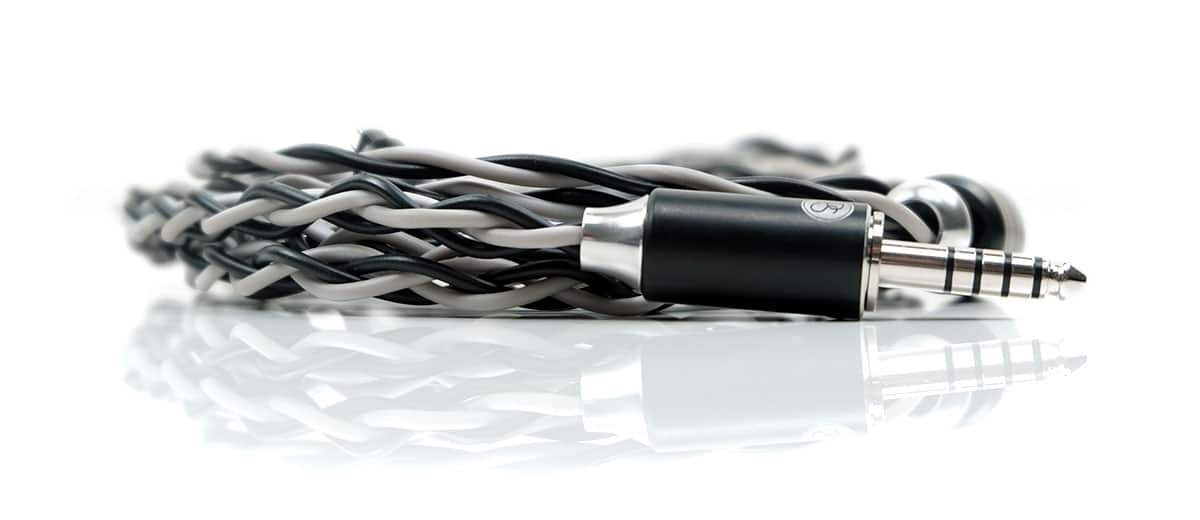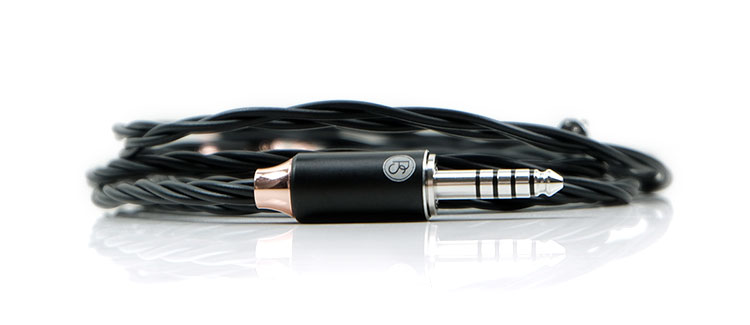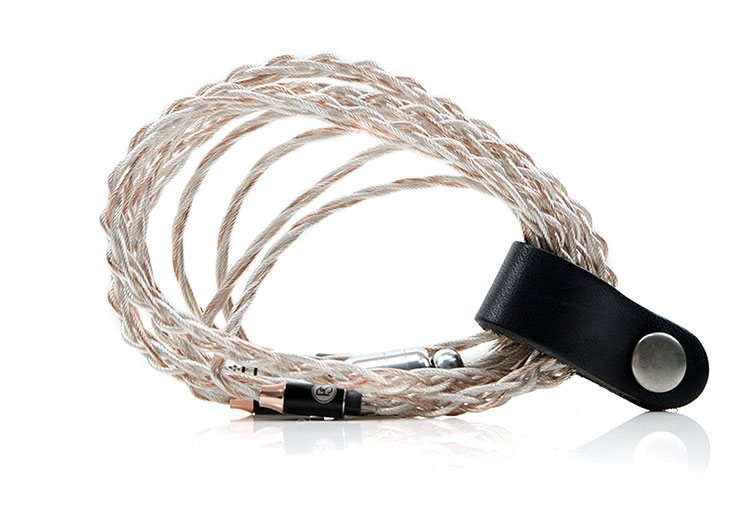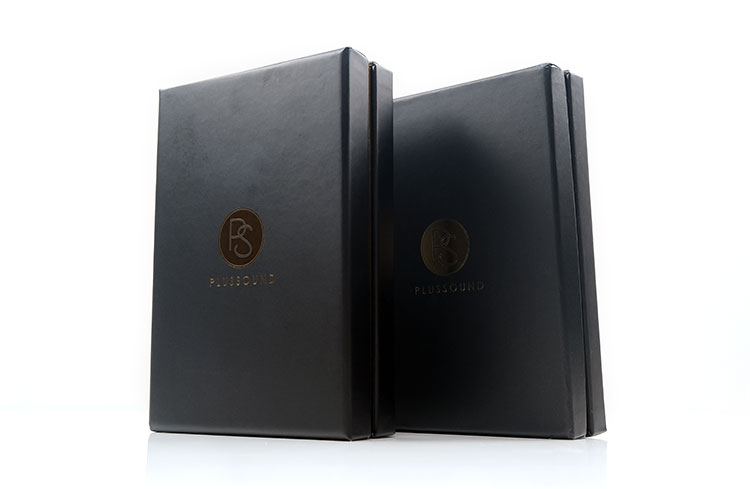Synergy
The Hybrid+ packs the type of punch that works exceedingly well with dynamic drivers or large sub-woofer BA alternatives. It is a little more prominent in the mid-bass rather than the sub-bass but it is nonetheless immediately noticeable.
Users of Empire Ear’s bassier variants such as the Legend EVO, or the Valkyrie MKII will find the Hybrid+ to be a more vibrant and visceral pairing than the smoother more chilled Copper+ or the reference neutral imaging and bass quantity of the Silver+.
The additional kick on the low-end is not just a high impact but also almost as well defined as the Silver+ with improved layering over the Copper+ softer performance.
At the same time, IEMs with electrostatic tweeters benefit from that injection of silver in the wiring. You get a shorter amount of decay and less dissonance through the upper mids of monitors such as the Noble Audio Sultan and the VE EXT compared to the older Tri-Hybrid cable. In return, the top-end of these IEMs sound very pristine and pure.
I was particularly enamored with the way the Hybrid+ gelled with mid-forward monitors such as the Odin. I had initially thought the boost in clarity and more vibrant treatment of the vocal imaging would perhaps make the Odin too shouty. However, despite the vocal prominence the tonal quality never felt sharp or fatiguing, not even close.
Granted, Copper+ will give you a smoother and more relaxed upper-mids on the Odin and if that’s what you are after the Hybrid+ might not be as ideal. I like a forward vocal though so long as it’s not sharp or brittle so the Hybrid+ works well for me in this instance.
Select Comparisons
PLUSSOUND Silver+
$1499.99
Technical
The Silver+ follows the exact same geometry or wire build format as the Hybrid+. That means a Litz build with an inner conductor and an outer shield sharing a geometric axis, PS insulation isolating the core, and PS Shielding to deal with EMI and other related factors that could cause interference in the signal.
The key technical difference between both cables internal is in the wire selection with the Hybrid+ using both UP-OCC copper and UP-OCC silver for the Hybrid+ in a 2 x 2 wire configuration rather than just UP-OCC silver for all 4 wires inside the Silver+.
You can see this technical difference reflected in the jackets with the braiding and blending of both the Silver+ matt grey jacket and the slightly thinner Copper+ black jacket into one cable.
Design
A big difference here visually as you would expect from reading the above with the two-tone matte grey and black of the Hybrid+ compared to the wholly matt grey experience of the Silver+
However, the handling and tensile feedback from both cables are almost the same. I say almost because the strands in the Silver+ are slightly thicker due to the more delicate nature of silver strands compared to copper.
That means that the 2-wire side of the Hybrid+, complete with the jacket, is slightly chunkier than the matt black copper 2-wires. Not noticeably so and only when you study it up close. I find that difference gives the Hybrid+ a very slight change in its handling and overall feel giving it a bit more retention when compressing in one hand.
Otherwise, both cables have the same properties including low microphonics and memory retention but are slightly stiffer in their handling compared to the classic PLUSSOUND transparent PVC cable builds.
Options for the Hybrid+ finishing such as barrels, plugs, and connectors are the exact same as the Silver+. I do like the supplied Hybrid+ sample finished color scheme with the black and silver barrels and connectors. Something similar on the matte grey of the Silver+ should give it an on-par visual.
Performance
The Hybrid+ is not as warm or soft sounding as the Copper+ when paired with the Sultan and the VE EXT but neither does it exact such a reference tone as the Silver+. It lies somewhere in between as you would naturally expect with a stronger sub-bass presence, a slightly smoother more flowing midrange, and a treble that sits back but is still quite lively.
On both the EXT and the Sultan the Silver+ bass is comparatively neutral but still punchy though with less body coming into the lower mids. The Hybrid+ delivers a low-end with a bit more aplomb and gusto and sounds excellent with bass-centric music.
The Silver+ has a stronger midrange performance for me but it is not quite as evenly balanced as the Hybrid+ for timbre. Not a negative but rather it is just the more accurate, precise, and articulate of the two cables through the mids and for the higher frequency spatial cues.
Again, the Silver+ loves those electrostatic drivers so you get some pristine clarity in the highs whereas the Hybrid+ is more liquid and natural in tone. The Hybrid+ is not as laid back as the Copper+ but rather than a precise clean tone or warmth through the mids, I would describe it more as sweet-sounding with a light smattering of treble overtones.
PLUSSOUND Copper+
$999.99
Technical
The technical specifications of both of these cables are virtually the same save for the choice of wire and the external finishing.
That means both are using a Litz build with an inner conductor and an outer shield sharing a geometric axis with the Hybrid+ using 2 wires of high purity UP-OCC pure silver and 2 wires of high purity UP-OCC copper. The Copper+ uses UP-OCC 24AWG copper for all 4 wires.
Both have the same gauge size at 24AWG though bear in mind that the 2 wires of silver have slightly beefier stranding so when jacketed the matte grey silver wire side looks marginally thicker.
The core of both cables is built using a single twist Litz configuration of each wire element with the outer layer also UP-OCC with 5-strand bundles in a Litz configuration. Both the single twist and 5 strand twists of each cable are enameled at the individual strand level to prevent the dreaded green oxidization effect.
Both cables use PS Insulation between the wire bundles to isolate them and PS Shielding just under the outer PS Insulation to protect the cable from EMI and other potential electrical interferences.
Design
The most striking aesthetical difference between these two cables is probably the jacket finishing. The Copper+ sample we have here uses a matte black twisted finish whereas the Hybrid+ sample uses a mix of both the Copper+ jacket and the Silver+ matte gray jacket to create a 2-tone effect.
The Copper+ twisted finish is a little thinner compared to the beefier braided Hybrid+ but in turn, I found the Hybrid+ braid finish to be a little more flexible for daily use.
Because both are a little stiffer than the older PVC constructions, handling is not quite as good and microphonics is a shade higher below the splitter. However, both are quite disciplined in their handling with very little in the way of memory retention when unfolded.
Finishing options are almost exactly the same and you do have the ability to mix and match barrels, jacks, and connectors at the PLUSSOUND website checkout.
Personally, the rose gold and blackjack/connector barrels look very stylish on the Copper+ and it looks a good fit. In the same manner, the silvery chrome finish of the Hybrid + barrels and stamped metal accents also suit its 2-tone jacket. We all have our own preferences but both look aesthetically spot on in terms of finishing.
Performance
The Copper+ is the more chilled performer when compared to the Hybrid+. You might also have an initial impression that the Hybrid+ is the less resistive cable because it sounds a little ‘bigger’ with all 3 of our tested monitors including the U18s, EXT, and the Sultan.
What I mean by bigger is the entire presentation gets punchier, more aggressive sounding, and further forward in the mids and treble. The detail that is smoothly presented from the Copper+ now jumps out at you with the Hybrid+ with some verve and a heightened sense of clarity.
That is likely the silver influence there shaping both the coloration and technical performance of the tested monitors. Definitely, it teases out a bit more treble extension, sparkle, and air but it also shapes and defined the bass punch a lot more.
As a result, you get a lot more perceived impact from the dynamic driver variants, and even when switching to the U18s BA setup the mid-bass punch was much more dominant which I was not expecting. I would say sub-bass reach is about the same but not quite as softly layered or as warm as the Copper+ performance.
The additional treble presence from the Hybrid+ pairings will also introduce some of that Silver+ midrange clarity and accuracy. The Copper+ is definitely sweeter in its delivery in comparison to the slightly more accurate and clear-sounding Hybrid+ mids.
PLUSSOUND Tri-Hybrid
$899.99
Technical
Both are hybrid material cables but this is a very different geometry to the Hybrid+. The Tri-Hybrid uses the company’s traditional Type 6 Litz approach to cable building as opposed to the new coaxial type design inside the Hybrid+.
This particular sample is 6-wire but it is also available in an EXO 4-wire version. The Tri-Hybrid is offered in a smaller 26AWG wire gauge compared to the 24AWG of Hybrid+. As far as I am aware the shielding on the Hybrid+ also runs the complete length of the cable which is not the case on the Tri-Hybrid.
In terms of materials, the Hybrid+ uses 2 elements. The elements are not blended with 2 wires of UP-OCC copper and 2 wires of UP-OCC silver. All wires have that coaxial-type dual Litz bundle geometry.
Whereas the Tri-Hybrid consists of 3 separate elements for every 2 wires making it 6 in total. This includes 2 wires of Tri-Silver, 2 wires of Tri-copper, and 2 wires of T-Metal, all their hybrid blended wires in one go.
Design
The aesthetic and handling are very different but there is some commonality around the finishing between the Tri-Hybrid and Hybrid+.
The translucent jacket of the Tri-Hybrid means a bright sparkling mix of gold, silver, and copper shining through, whereas the Hybrid+ finishing is 2-tone grey and black with black and silver barrel accents.
In terms of overall dimensions, the Hybrid+ braiding is slightly thinner despite having a larger gauge size but stiffer making it feel somewhat bigger in your hand. Similar barrel and connection materials mean the overall weight difference between these two cables is negligible.
The handling is where the Tri-Hybrid has a slight edge with its braided softer structure allowing for less microphonics below the splitter. Both offer good handling discipline but the Hybrid+’s braided finish is a little more resistant to tighter rolling when not in use whereas the Tri-Hybrid is more pliable for that and not as stiff in the hand either.
Both have the same jack, barrel, cinch, and connector options when purchasing but from a preference point of view, an all rose gold on the Tri-Hybrid rather than a silver splitter and cinch would be perfect.
Performance
The Hybrid+ has some advantages over the Tri-Hybrid namely a slightly better dynamic range which, in turn, delivers a blacker background and a bit more staging depth.
However, for hybrid IEM lovers, there is a bit of a difference in how both cables approached electrostatic driver performances in 2 of our monitors, the EXT and the Sultan.
The Tri-hybrid is what I would consider being more neutral sounding with less of a bass lift and volume and teasing out more of an airy mids and highs presence. Now, with electrostatic driver IEMs you get a nice clear treble image with plenty of energy as a result. However, it does not have quite the same control as the Hybrid+’s treatment of the same drivers.
For example, the EXT treble and upper-mids have a shade more harmonic dissonance creeping through with the Tri-Hybrid, perhaps a slightly shaper overtone and a longer decay. Whereas the Hybrid+, with the same IEM, sounded more like a pure electrostatic driver meaning more delicate, more controlled, with improved articulation in its delivery.
Some of this might be attributable to a slight harmonic imbalance from the Tri-Hybrid when compared to the Hybrid+ which digs deeper and produces a fuller low-end performance from those EXT and Sultan dynamic drivers.
Notes simply sound smoother and more robust whereas the Tri-Hybrid is comparatively lacking in the same rich even-harmonic underbelly to balance out the highs as well.
That translates also to the vocals on our two IEMs where a combination of the slightly reduced dynamic range and the more neutral imaging of the Tri-Hybrid doesn’t sound quite as vivid and holographic to my ear when compared to the Hybrid+.
Our Verdict
With all 3 cables in PLUSSOUND’s ‘+’ series covered I have to admit out of the three, I have a slight bias towards the Hybrid+ in terms of how well it performs with my tested monitor lineup.
It teases out a big-sounding, vivid, and engaging quality to beefy dynamic driver setups and pushes hard on the mid-bass punch with woofer BA configurations.
The blend of both metal elements is more refined than previous blended alloy creations in PLUSSOUND’s line-up so it is not all about the impact either. Electrostatic and smaller BA tweeters sound very balanced, pure, and clear with this cable pairing.
If you can’t decide between the relaxed warmth of the Copper+ or the clean reference tone of the Silver+ then this is an excellent and engaging mix-up of both of their qualities.
PLUSSOUND Hybrid+ Specifications
- Wire: UP-OCC Silver & UP-OCC Copper
- Gauge: 24AWG
- Core Count: 4
- Geometry: 2 in 1 Coaxial-Type Litz
- PS Insulation (new proprietary matte grey)
- PS Shielding – semi-conductive + ground layer
- Length: 1.2m (longer upon request)





